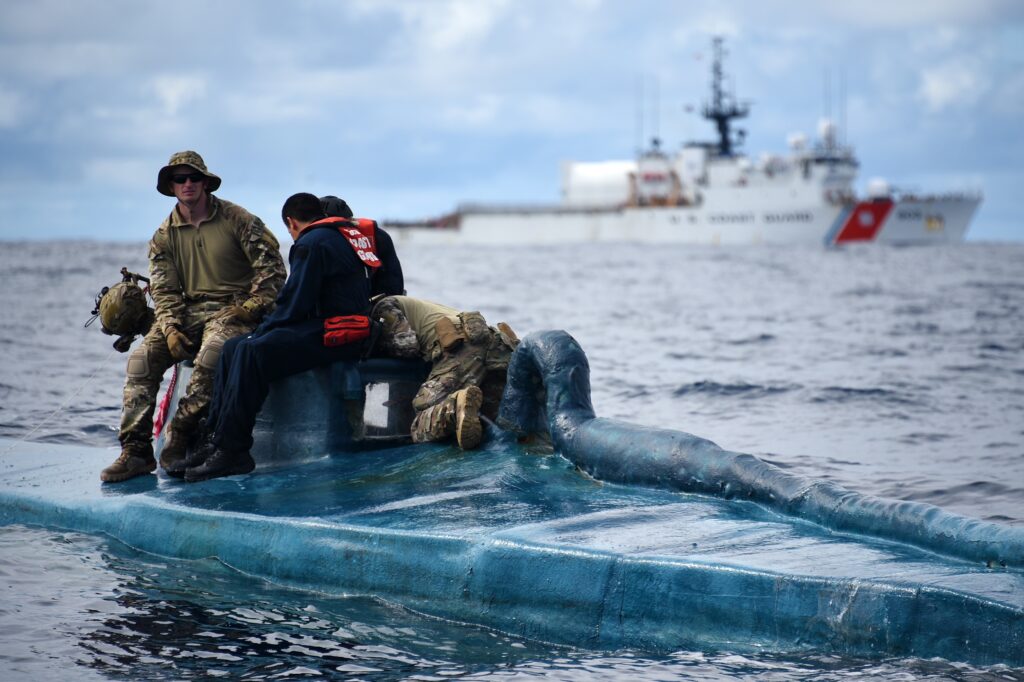29 Apr Silent Currents: The Evolution and Strategic Implications of Narco Submarines in the Americas
By,
Jesús Daniel Romero, Co-Founder and Senior Fellow, MSI²
For over two decades, the clandestine use of low-profile vessels (LPVs), semi-submersibles, and the rare but technically advanced fully submersible craft has evolved from a maritime curiosity to a formidable logistics tool of transnational criminal organizations (TCOs).
These vessels are often referred to as “narco submarines” in popular media, but that term is a misnomer. Most are not true submarines—they do not fully submerge or operate like military subs. Instead, they are designed to evade detection by minimizing radar, visual, and thermal signatures while remaining just at or below the waterline (Felbab-Brown, 2020).
Drawing from my previous assignments in Peru, Ecuador, and Guatemala, I have witnessed firsthand the transformation of this covert capability—engineered deep in the jungles of the Pacific corridor and now expanding into the Caribbean basin. These platforms are optimized for one purpose: the undetected transport of tons of cocaine and illicit cargo across hemispheric waters (U.S. Drug Enforcement Administration [DEA], 2024).
The Tactical Evolution of Narco Subs
“Narco-submarine” technology has progressed rapidly since the early 1990s, when Colombian cartels began experimenting with crude, fiberglass-constructed vessels. Today’s LPVs can stretch over 30 meters, carry multi-ton payloads, and navigate thousands of nautical miles with GPS, radar reflectors, and satellite communication—a fusion of low-tech disguise and high-tech navigation (Bonner, 2019).
During my assignment in Guatemala, I saw firsthand the arrival and final destinations of hundreds of low-profile and semi-submersible vessels transiting the Eastern Pacific corridor. Local villagers often reported these vessels washing up or adrift at sea along Guatemala’s Pacific coastline. These were not rare anomalies—they constituted a persistent and well-oiled logistics operation, feeding northern drug markets with industrial consistency (DEA, 2024).
On the other side of the equation, Ecuador’s jungles have become key construction hubs, particularly in the Esmeraldas region and its inland river systems. Narco yards—camouflaged beneath dense canopy and protected by cartel militias—produce these vessels with alarming speed and efficiency, using modular materials and repurposed truck engines (Felbab-Brown, 2020).

Venezuela’s Entry into the Game
In recent years, Venezuela has emerged as a new and growing actor in the narco-submarine ecosystem, not just as a launch point but as a builder of these platforms. Intelligence reports and interdiction cases confirm the existence of clandestine construction facilities in Venezuelan coastal states, particularly in Zulia and Falcón, with vessels destined for Africa, Europe, and the Caribbean (InSight Crime, 2023).
This expansion represents a significant shift in the hemispheric drug trade. While traditional narco-sub routes aimed at the United States via Central America, Venezuelan operations increasingly target European and West African markets, exploiting under-patrolled waters and fragmented maritime cooperation in the Atlantic basin (MAOC-N, 2022).
Advanced Semi-Submersibles and Geographic Expansion
Some of the most advanced semi-submersibles have been discovered along the border regions between Colombia and Ecuador. These highly sophisticated vessels, capable of carrying large loads over vast distances, are evidence of how narco-trafficking organizations have adapted to increasingly robust interdiction efforts (DEA, 2024).
Moreover, semi-submersibles have been found operating in the Meta and Orinoco rivers—two critical locations in Colombia and Venezuela. These regions are increasingly becoming logistical hubs for illicit drug shipments, where narco-subs operate in tandem with transnational crime syndicates (Felbab-Brown, 2020).
In Venezuela, LPVs, including Self-Propelled Semi-Submersibles (SPSS), have been detected navigating the Meta and Orinoco rivers, leveraging these waterways’ dense vegetation, remote tributaries, and navigable channels to transport cocaine from production zones to coastal launch points. The Orinoco River, with its vast delta and connections to the Atlantic, serves as a critical artery for smuggling, particularly in the Delta Amacuro region. The Meta River, forming part of the Colombia-Venezuela border, facilitates cross-border trafficking, with LPVs moving cocaine from Colombian coca fields to Venezuelan hubs like Puerto Carreño. These riverine operations exploit lax enforcement and political instability in Venezuela, where state complicity and weak maritime governance enable TCOs to construct and deploy LPVs in hidden riverine shipyards. Interdicting these vessels in narrow, forested river systems poses unique challenges, as their low radar signatures and ability to submerge partially thwart traditional surveillance, necessitating specialized riverine patrols and real-time intelligence (Felbab-Brown, 2020).
The Caribbean basin, including areas near Puerto Rico, has also emerged as a trafficking corridor for narco-submersibles and LPVs. In April 2021, U.S. authorities intercepted a 52-foot narco-submersible carrying 5,500 pounds of cocaine, valued at $75 million, destined for Puerto Rico (Bloomberg, 2021). Additionally, in August 2024, a joint U.S. Coast Guard and British Royal Navy operation in the Caribbean Sea seized 1,239 pounds of cocaine worth $54 million from an LPV (MAOC-N, 2022).
Design, Performance, and Tactical Challenges to Law Enforcement
The design and operational profile of narco-submarines present severe challenges to both detection and interdiction:
- Low Radar Cross Section: Most vessels are constructed with fiberglass, dramatically reducing their radar signature (Bonner, 2019).
- Minimal Freeboard: LPVs typically ride only 12 to 18 inches above the waterline, making them extremely difficult to detect (DEA, 2024).
- Range and Endurance: Newer models can travel over 2,000 nautical miles nonstop.
- Autonomous or “Ghost” Capability: Some are designed to scuttle with GPS-triggered sink mechanisms.
- Crew Compartmentalization: Built for multi-day voyages, often equipped with satellite phones, oxygen tanks, and food reserves.
U.S. law classifies these vessels as Self-Propelled Semi-Submersibles (SPSS). The Drug Trafficking Vessel Interdiction Act of 2008 (DTVIA) criminalized the operation of stateless SPSS in international waters (U.S. Coast Guard, 2023).
A Visual Archive of the Threat
During multiple visits to the Fuerzas Especiales Navales (FEN) base in Puerto Quetzal, Guatemala, I witnessed firsthand a haunting display: a graveyard of captured narco-submarines, rotting and withering away under the relentless coastal sun. The base has become a dumping ground for hundreds of seized vessels—ghostly relics of interdicted voyages. At its center lies a so-called VIP row: a curated lineup that charts the evolution of semi-submersibles and low-profile vessels. Each rusting hull tells a story of adaptation and defiance, a silent record of how transnational criminal organizations continually refine their maritime capabilities to stay ahead of the law.
I have seen similar scenes in Guayaquil, Ecuador, and Bahía Málaga, Colombia—each a quiet museum of the narco-submarine arms race. These confiscated hulls are not only tactical trophies but monuments to a persistent and evolving threat.
Limitations of Maritime Interdiction
While maritime interdiction operations have seized record volumes of cocaine in recent years, they have not reduced the overall flow. Criminal networks have adapted with a resilient supply chain and overwhelming volume (UNODC, 2023).
The 2019 U.S. Coast Guard operation aboard the USCGC Munro became iconic after a team intercepted a 40-foot SPSS, seizing 17,000 pounds of cocaine valued at $232 million. A Coast Guardsman leapt onto the vessel, shouting “Alto Su Barco!”—a viral symbol of maritime interdiction (U.S. Coast Guard, 2023).
However, such victories do not permanently disrupt the resilient supply chains originating in regions like Venezuela’s Meta and Orinoco rivers. The “Alto Su Barco!” moment underscores the Sisyphean nature of interdiction and reinforces the need for upstream disruption (Felbab-Brown, 2020).
Colombian President Gustavo Petro’s de-emphasis on coca eradication has also contributed to surging production. The UNODC’s 2023 report confirmed coca cultivation reached historic highs, exacerbated by a permissive environment for narco-guerrilla groups (UNODC, 2023).
Further compounding this crisis, in late 2023, the Biden administration suspended the United States’ coca crop monitoring program in Colombia — a strategic misstep that eliminated one of the most effective early-warning systems for tracking cocaine production surges.
This critical tool, operated by the U.S. Office of National Drug Control Policy (ONDCP), had provided policymakers and interdiction planners with real-time visibility into coca cultivation hotspots for decades.
The suspension coincided with a broader stagnation in ONDCP leadership, reflecting a failure to recalibrate U.S. counter-drug efforts amid the rapidly evolving hemispheric narcotics landscape.
Rather than adapting to the expansion of transnational criminal organizations’ maritime capabilities, the U.S. response under the Biden administration became increasingly reactive, constrained, and data-deficient.
Without proactive intelligence gathering and coca monitoring, the United States now risks flying blind at a critical moment—allowing narco-subs, riverine LPVs, and industrial-scale cocaine production to expand with greater impunity across Colombia, Venezuela, Ecuador, and into the Caribbean basin.
This self-inflicted intelligence gap will have long-term consequences not only for maritime security but also for broader hemispheric stability and U.S. national security interests.
Strategic Implications: A Nexus of National Security and Transnational Threats
Narco-subs symbolize a strategic convergence of criminal innovation and state failure. Each successful voyage undermines the rule of law and fuels regional instability. Their dual-use potential—for smuggling weapons or personnel—makes them a potential vector in gray-zone conflict (Felbab-Brown, 2020).
A single successful SPSS can net up to $125 million in the U.S. and $375 million in Europe, depending on purity and route (InSight Crime, 2023). The immense financial rewards only fuel continued innovation and risk-taking by TCOs.
Policy Recommendations
- Focus on Coca Reduction in Colombia: Prioritize eradication and rural development.
- Disrupt the Supply Chain: Target welders, financiers, and materials.
- Expand ISR Coverage: Improve real-time intelligence sharing.
- Strengthen Littoral Security: Train partner forces for riverine and coastal operations.
- Apply Targeted Sanctions: Use the Kingpin Act against actors in Ecuador and Venezuela.
- Engage European and African Partners: Treat narco-sub trafficking as a global issue.
Conclusion
Narco submarines represent a hybrid maritime threat. These vessels adapt, innovate, and persist beneath the radar of conventional security frameworks. From the Pacific mangroves of Colombia and Ecuador to the politically opaque coastlines of Venezuela and the vulnerable waters near Puerto Rico, they chart a silent but deadly path across hemispheres.
Our partner nations—Colombia, Ecuador, Panama, El Salvador, Guatemala, and Mexico—serve as the first line of defense in this fight. Equally critical is the work of U.S. law enforcement and the Coast Guard, whose relentless interdiction efforts and intelligence collection have saved lives. This is not just a war on drugs—it is a battle for maritime sovereignty, regional stability, and the rule of law on the high seas.
References
Bloomberg. (2021, April 23). U.S. seizes submarine carrying $75 million in cocaine off Puerto Rico. Bloomberg. https://www.bloomberg.com/news/articles/2021-04-23/u-s-seizes-submarine-carrying-75-million-in-cocaine-off-puerto-rico
Bonner, R. (2019, March 5). Narco submarines: Out of sight, under water. Foreign Affairs. https://www.foreignaffairs.com/articles/colombia/2019-03-05/narco-submarines-out-sight-under-water
Felbab-Brown, V. (2020, November 24). Narco-submarines: Drug cartels’ newest weapon. Brookings Institution. https://www.brookings.edu/articles/narco-submarines-drug-cartels-newest-weapon/
InSight Crime. (2023, May 15). Venezuela’s expanding role in the narco-submarine trade. InSight Crime. https://insightcrime.org/news/venezuela-expanding-narco-submarine-trade/
Maritime Analysis and Operations Centre – Narcotics (MAOC-N). (2022). Annual report on maritime drug trafficking 2022. https://maoc.eu/publications/annual-reports/
U.S. Coast Guard. (2023, July 17). Cutter Munro makes historic narco-sub seizure. United States Coast Guard Newsroom. https://www.news.uscg.mil/Press-Releases/Article/3455669/cutter-munro-makes-historic-narco-sub-seizure/
U.S. Drug Enforcement Administration (DEA). (2024). National Drug Threat Assessment 2024. U.S. Department of Justice. https://www.dea.gov/documents/2024/04/01/2024-national-drug-threat-assessment
United Nations Office on Drugs and Crime (UNODC). (2023). Colombia: Coca cultivation survey 2023. United Nations. https://www.unodc.org/unodc/en/crop-monitoring/colombia/index.html
